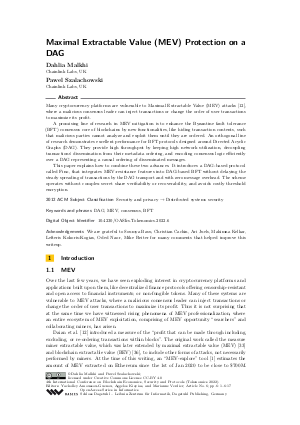@InProceedings{malkhi_et_al:OASIcs.Tokenomics.2022.6,
author = {Malkhi, Dahlia and Szalachowski, Pawel},
title = {{Maximal Extractable Value (MEV) Protection on a DAG}},
booktitle = {4th International Conference on Blockchain Economics, Security and Protocols (Tokenomics 2022)},
pages = {6:1--6:17},
series = {Open Access Series in Informatics (OASIcs)},
ISBN = {978-3-95977-274-7},
ISSN = {2190-6807},
year = {2023},
volume = {110},
editor = {Amoussou-Guenou, Yackolley and Kiayias, Aggelos and Verdier, Marianne},
publisher = {Schloss Dagstuhl -- Leibniz-Zentrum f{\"u}r Informatik},
address = {Dagstuhl, Germany},
URL = {https://drops.dagstuhl.de/entities/document/10.4230/OASIcs.Tokenomics.2022.6},
URN = {urn:nbn:de:0030-drops-184231},
doi = {10.4230/OASIcs.Tokenomics.2022.6},
annote = {Keywords: DAG, MEV, consensus, BFT}
}

 Creative Commons Attribution 4.0 International license
Creative Commons Attribution 4.0 International license

































